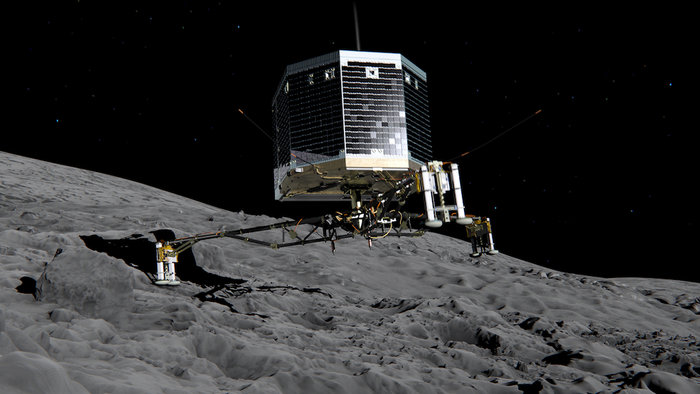The Rosetta probe was launched in 2004 by the European Space Agency to chase and ultimately rendezvous with the Churyumov-Gerasimenko Comet also known as Comet 67P. It completed its mission last week and is in orbit around Comet 67P this week. Upon arriving at Comet 67P, the Rosetta probe launched the Philae Lander for a soft landing on the comet. The approach and landing worked exactly as planned but then the problems began.
The gravity of the comet is one ten thousandth the gravity of the Earth so the lander might possibly drift away from the surface if not tied down. In planning for the landing, the project team made some assumptions about the nature of the surface of the comet. It was believed that the comet's surface would be solid. Each of the three legs of the lander is equipped with a drill. As the lander touched down, the drills would be deployed to drill into the rocky surface and hold it in place. There were also anchors that could be fired from the lander to provide additional attachment to the comet. It turned out that the surface of the comet was not the hard rock that was expected but more gravel and dust. The drills did not anchor the lander as expected and the anchors were useless.
One of the experiments that was supposed to be carried out by the lander was the scooping up of surface material by a robotic arm on the lander. If the arm was deployed, its gentle contact with the comet's surface might push the lander away from the comet. The project team had considered the possibility of problems with keeping the lander on the comet and they had added a thruster to the top of the lander so they could have it expel puffs of gas to push the lander down. Unfortunately it turned out that the pin that was supposed to push the plug of wax out of the nozzle of the thruster was unable to actually remove the wax so the thruster could not be used.
The project team did deliberately cause the lander to push off from the comet after it first touched down. The lander drifted back to the comet but that did not improved the situation. After a second attempt to reposition the lander, it drifted back to the comet next to a cliff which cut off sunlight to the lander's solar panels. The lander was able to conduct some experiments before it lost power.
After all the hard work and ten years for flight, the Rosetta probe reached the target comet just as planned. Unfortunately, a combination of mistakes in planning and equipment malfunctions combined to shut down the lander after a few hours of operation.
Philae Lander for the Rosetta mission:
